Ch. 20 Math Interventions and Strategies
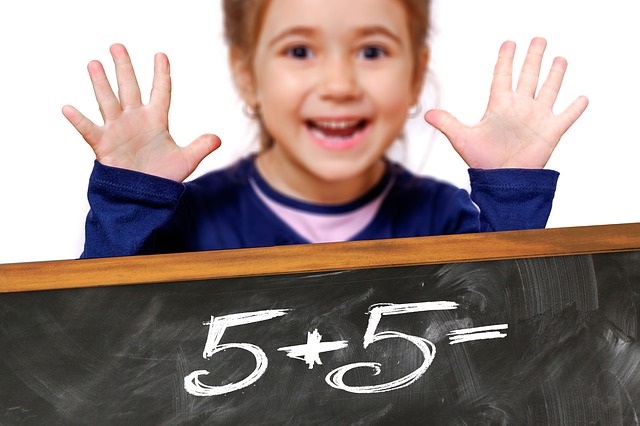
This next section contains excerpts from National Center on Intensive Intervention. (2016). Principles for designing intervention in mathematics. Washington,
DC: Office of Special Education, U.S. Department of Education and is in the pubic domain.
![]() The purpose of this chapter is to provide brief explanations of practices that can be implemented when working with students in need of intensive intervention in mathematics.
The purpose of this chapter is to provide brief explanations of practices that can be implemented when working with students in need of intensive intervention in mathematics.
Special education instructors, math interventionists, and others working with students who struggle with mathematics may find this guide helpful. The strategies presented in this guide should be used in conjunction with teaching guides developed for specific mathematical concepts. Specific topics covered include the following:
Explicit, Systematic Instruction (aka Direct Instruction)- Chapter 4
•Effective Questioning in the math classroom (questioning was introduced in chapter 9)
•Concrete, Representational/Visual/Pictorial, Abstract/Symbolic Models
•Teaching Mathematical Vocabulary and Symbols
•Fluency Building
•Error Analysis
Concrete, Representational/Visual/Pictorial, and Abstract/Symbolic Models
Using multiple representations to teach mathematics allows students to understand mathematics conceptually, often as a result of developing or “seeing” an algorithm or strategy on their own. By building strong conceptual understanding, students are able to better generalize skills and understand algorithms (Gersten et al., 2009; Jones, Inglis, Gilmore, & Evans, 2013; Miller & Hudson, 2007). Moving through each phase is essential for every skill area, not just for early foundational skills (Jayanthi et al., 2008; National Mathematics Advisory Panel, 2008; Stein, Kinder, Silbert, & Carnine, 2005; Woodward, 2006). A description of the three phases follows.
1. Concrete: In this phase, students use three-dimensional manipulatives to solve problems and to gain a better conceptual understanding of a concept. Examples of manipulatives include counting bears, snap cubes, base-10 blocks, real or plastic money, clocks, fraction tiles, geoboards, Algeblocks, algebra tiles, and
others. It is helpful to use a variety of manipulatives (if possible) to teach concepts so that students can generalize the concept being taught. Using an assortment of manipulatives is not always possible, however; some concepts can only be taught using a specific manipulative. It is important to note that although students may demonstrate proper use of a manipulative, this does not mean that they understand the concepts behind use of the manipulative. Explicit instruction and student verbalizations, such as explaining the concept or demonstrating use of the manipulative while they verbally describe the mathematical procedure, should accompany all manipulative use.
2. Representational/Visual/Pictorial: Students use two-dimensional pictures, drawings, or diagrams to solve problems. These pictures, drawings, or diagrams may be given to the students, or they may draw them when presented with a problem. These representations should be used to connect and solve the same concepts previously taught using concrete objects. Representational models also may be presented virtually through websites or tablet applications. With a virtual representation, students move the image with a mouse or with their hands.
3. Abstract/Symbolic: During this phase, students are expected to solve problems through the use of numbers and symbols rather than with the use of concrete objects or visual representations. Students are often expected to memorize facts and algorithms as well as to build fluency.
Following is an example that demonstrates use of the three phases to solve the problem 4 + 5:
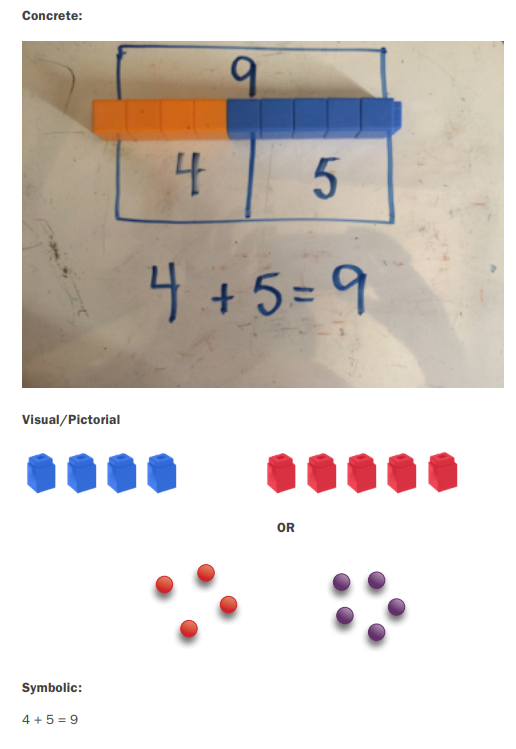
Effective Questioning and Providing Feedback
![]() Students who have difficulty with mathematics need many opportunities to respond to effective questions, explain their thinking, and receive feedback that allows them to improve their learning. To increase generalization of skills and flexibility in thinking mathematically, instructors need to ask questions that increase student engagement, that provide feedback, and that are linked to algebraic or higher level thinking and understanding (Cai & Knuth, 2005; Witzel, Mercer, & Miller, 2003). Specifically, beginning algebraic thinking, such as analyzing relationships, generalizing models, predicting, justifying, or noticing structure, can lead to greater gains in mathematics understanding in later years (Kieran, 2004).
Students who have difficulty with mathematics need many opportunities to respond to effective questions, explain their thinking, and receive feedback that allows them to improve their learning. To increase generalization of skills and flexibility in thinking mathematically, instructors need to ask questions that increase student engagement, that provide feedback, and that are linked to algebraic or higher level thinking and understanding (Cai & Knuth, 2005; Witzel, Mercer, & Miller, 2003). Specifically, beginning algebraic thinking, such as analyzing relationships, generalizing models, predicting, justifying, or noticing structure, can lead to greater gains in mathematics understanding in later years (Kieran, 2004).
Following are guidelines for asking questions that will move student learning forward, increase student engagement, and offer immediate feedback.
1. Questioning: The three main types of questions that should be used in mathematics are reversibility, flexibility, and generalization (Dougherty, Bryant,
Bryant, Darrough, & Pfannenstiel, 2015).
- Reversibility questions are those that change the direction of student thinking: for example, giving the student the answer and asking him or her to identify the correct equation. This type of question allows for multiple answers and gives students the opportunity to think about algorithms in different ways. Reversibility questions should be presented after the student has demonstrated mastery of a particular procedure or algorithm.
- Flexibility questions support student understanding in finding multiple ways to
solve a problem or in discerning relationships among problems. For example, the student might be asked to solve an addition problem using a specific strategy and then show or prove the answer using another method, such as a number line. Flexibility questions can be used during instruction to show relationships between similar problems or differences in models. - Generalization questions are those that ask students to create statements about patterns. In the past, instructors would explain algorithms or rules, and they did not afford students the opportunity to develop explanations on their own. To increase conceptual understanding, guided questions about patterns allow rules or generalizations to be “discovered” by the student. For instance, students are presented with a list of numbers multiplied by two and then asked to describe any patterns they notice (e.g., one factor is two, product is an even number, etc.). The use of generalization questions allows students to develop a deeper understanding of mathematics and to generalize their thinking to similar problems.
Regardless of the type of questions asked, instructors should use the questioning strategy to assess student understanding and then use the information obtained from the questioning to evaluate and adjust their instruction as necessary.
Teachers should involve all students in questioning. This involvement can be accomplished in several ways:
First, teachers may invite all students to respond to questioning through unison choral response. Although this is an easy way to encourage students to respond, it is important to ensure that all students are responding to the questions at the same time.
Second, teachers can use equity sticks. Teachers write each student’s name on an ice pop stick and then draw a stick for each question they ask. The student whose name appears on the stick answers the question. All students have the same chance to be called upon.
Third, teachers may use response cards. Write “A,” “B,” and “C” on separate cards. The instructor asks a question and presents three answer choices. Students select their choice and hold up the response card indicating their answer.
Fourth, teachers may ask students to write their answers on whiteboards. Students hold up the answers so the instructor can check them for accuracy.
Fifth, teachers may invite students to create a model. Students then pair-share their creations to identify differences and similarities among the models and answers to the mathematical questions.
Teachers may need to individualize their questions for students to gain a better understanding of a particular student’s knowledge of the skill that is being taught.
2. Feedback: Providing students with both positive and corrective feedback is essential to their learning. It is important that students receive immediate feedback so that they do not continue to practice incorrectly. Students should also have an opportunity to practice/repeat the correct response after error correction has been provided (Archer & Hughes, 2011).
Teaching Vocabulary and Symbols
Students with a strong mathematical vocabulary will have a better understanding of the concepts and skills being taught. Instructors, therefore, should use precise language when teaching mathematical concepts and skills. Explicit teaching of vocabulary and mathematical symbols is important in helping students understand mathematical concepts, and this explicit instruction should be integrated into all lessons. Encouraging student verbalization of mathematics vocabulary, paired with explicit instruction in identifying and using symbols, can increase overall mastery of symbolic representation (Driver & Powell, 2015; Frye, Baroody, Burchinal, Carver, Jordan, & McDowell, 2013).
Examples for teaching mathematics vocabulary and symbols are explained in this section.
1. Word Walls/Word Banks: Word walls and word banks can be used in two ways. First, instructors can create cards with vocabulary terms or symbols and the corresponding definitions. Second, students can create their own cards. Once cards have been created, they are placed on a word wall, or students can keep their own notebook containing the terms. When the word wall or student notebook is organized, the words should be placed in meaningful sections. For example, one section may be devoted to fractions, another section to basic operations, another to geometry terms, and so forth. This meaningful organization will help students when they are looking for the terms. It is important to note that simply placing word cards on the wall or having students add them to their notebooks does not increase student understanding of the vocabulary or symbols. Instructors must teach these vocabulary terms and symbols and their definitions and then relate the terms and symbols to student learning. Instructors should use precise mathematical vocabulary in teaching and correcting, and they should also encourage students to use correct mathematical language in speech.
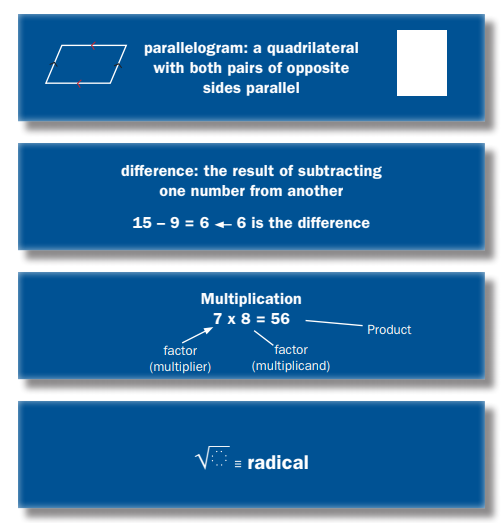
2. Vocabulary Cards: These cards may have the same vocabulary terms and symbols as those on the word wall or word bank. If instructors use vocabulary cards to teach definitions, they should write each term on the front of a card and its definition on the back. When the cards are used to teach symbols, the instructor should write each symbol on the front of a card and its name on the back. The cards are used as a practice activity in which students quickly say the word and state its definition or identify a symbol and cite its meaning. Through vocabulary card practice activities, students will learn to automatically recognize mathematical vocabulary terms and symbols.
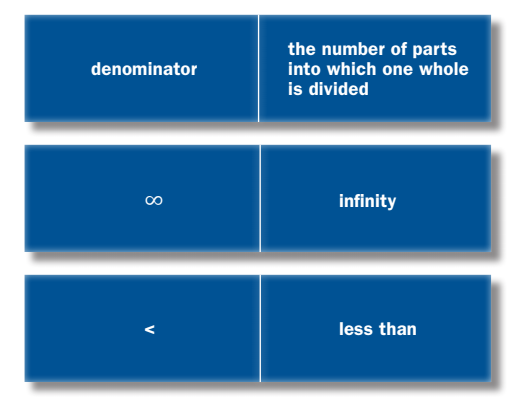
3. Labeling: Students are expected to label parts of a problem or figure in mathematics. Often, students need opportunities to identify vocabulary terms prior to solving problems. To increase overall mathematical vocabulary and flexibility, problems should be written in a variety of ways to show variability. Providing students with examples such as the ones below will enable instructors to assess students’ understanding of terms prior to problem solving.
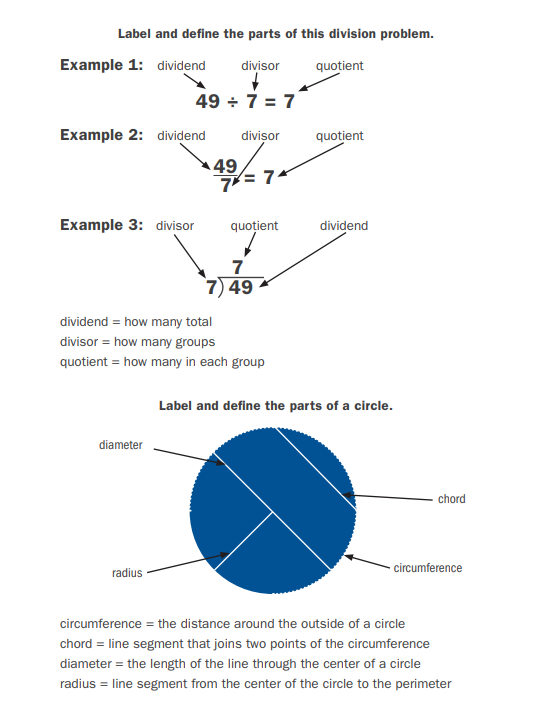
4. Identifying Characteristics: Some mathematical terms or concepts are more complicated than others and require further explanation as well as examples and non-examples. A characteristics table presents information in a manner that is easy for students to access. When a term or concept is introduced, instructors and students should complete a characteristics table together. In the first box, characteristics of the term/concept are listed. In the second box, examples of the term/concept are provided. In the third box, non-examples are listed. For some concepts or terms, it may be helpful to provide pictures of the examples and non-examples.
polygon: a simple, closed plan figure made up of three or more line segments

Graphic Organizers
Graphic organizers are helpful mathematics tools; they allow a great deal of information to be logically organized in one place. Graphic organizers, such as the three variants of the Frayer Model that follow, are an efficient alternative to extensive note taking. Instructors explicitly teach students how to use the graphic organizer and the content provided. Graphic organizers can be used to illustrate most mathematical concepts.
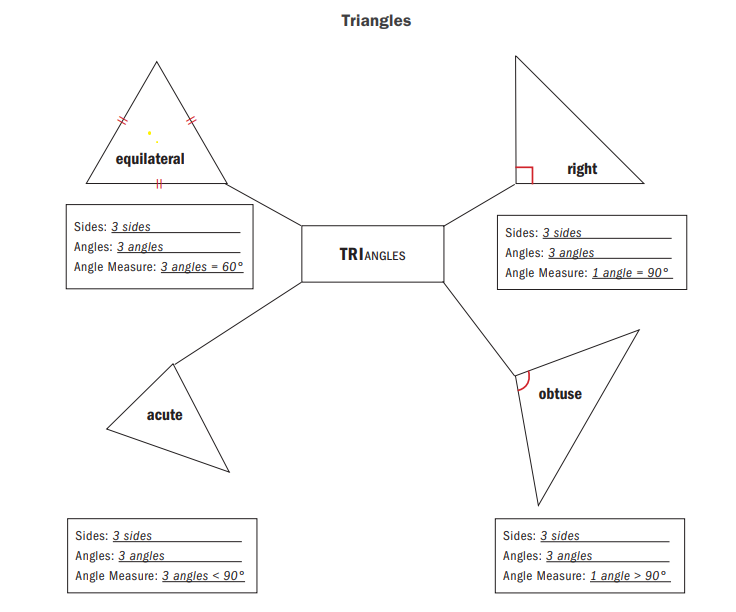
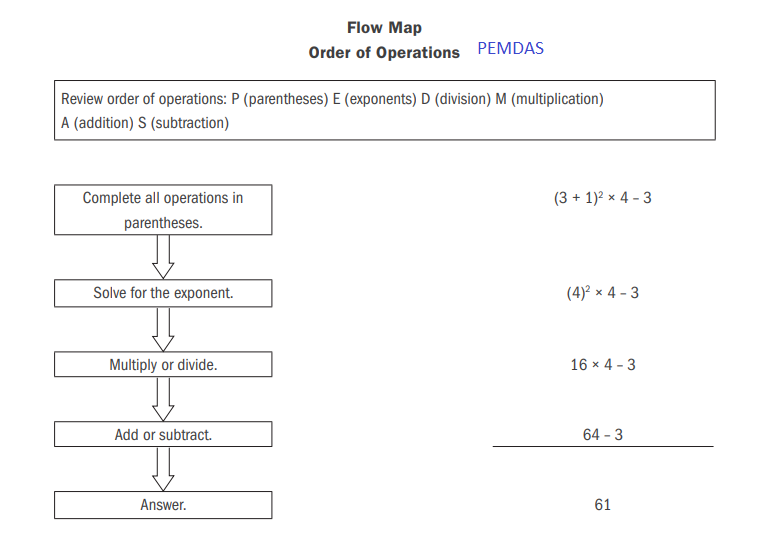
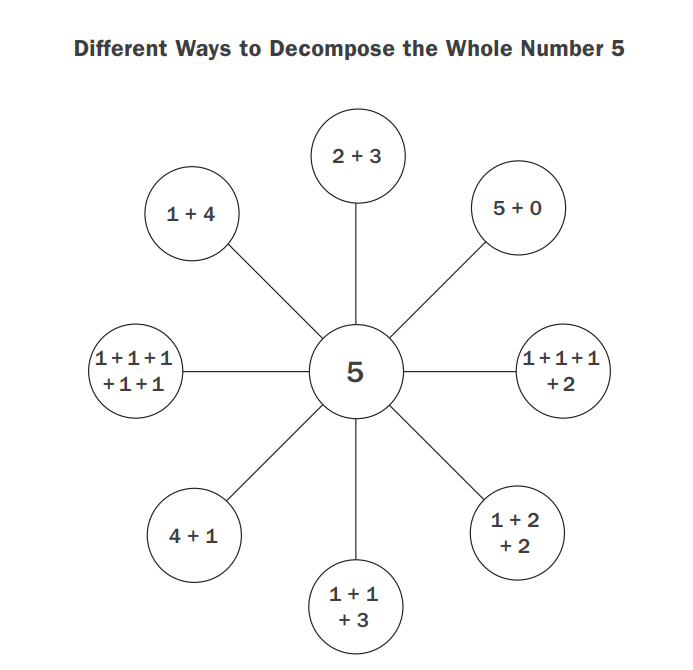
Fluency Building
In addition to conceptual knowledge, students need to develop procedural fluency in mathematics. Providing students with practice activities that build fluency is essential. Opportunities to work through multi-step problems allow students to develop the higher-level thinking skills they need in order to progress to more complicated math concepts. Students need effective strategies and ample practice to increase their fluency in basic mathematics skills such as operational facts. The only way to truly increase fluency is to combine timed activities with additional practice opportunities (Raghubar et al., 2010; Woodward, 2006).
Another benefit of fluency can be enhanced motivation. When students become more fluent in mathematics skills, their motivation and confidence often increase. To heighten motivation, students should self-correct whenever possible for immediate feedback and then graph the results. Instructors also can integrate goal setting to further motivate and increase student self-regulation (Burns et al., 2010; Codding et al., 2009; Montague, 2007; Rock, 2005). Following is a list of suggested activities that instructors may use for fluency building practice. Many of these activities can be incorporated into peer tutoring activities.
1. Timed Activities: The use of timed activities to increase fluency in demonstrating knowledge of basic facts is a mainstay of mathematics education. The purpose of timed tests is to motivate students to increase their speed and to surpass their previous scores. Although timed activities are an effective tool for building fluency, they should not be the sole mode of instruction. Instructors should explicitly teach strategies that aid students in demonstrating their knowledge of mathematical facts. It is important to note that timed activities are not a motivator for all students; the focus, therefore, should be on answering correctly as well as quickly answering questions related to mathematical facts.
2. Flash Cards: Flash cards are often used to improve fluency in demonstrating knowledge of basic facts. They also can be used in activities such as identifying coins and their values, reading clocks, identifying fractions, and performing other mathematical tasks. Flash cards can be used with students and instructors or with peer tutors. Answers are provided on the backs of the cards so that the flash cards can be worked through quickly. Peer tutors should be taught how to correct answers so that neither peer is practicing the wrong answer during flash card activities. Students should record items scored as “incorrect” so that they can further practice the specific skills associated with these items. Students can graph the total number of flash cards answered correctly under timed conditions. This graphing can be done in tandem with goal setting to motivate the development of fact fluency.
3. Computer Software: Computer software activities, when paired with explicit teaching, can be highly engaging for students. Computer software programs provide the additional practice that struggling students need to increase mathematics fluency and accuracy. Instructors should evaluate software programs to ensure that they meet the needs of students and that they require students to actively solve problems. Effective computer software will contain clear directions and will provide students with positive and corrective feedback immediately after they have answered questions (i.e., worked through problems). Computer programs should complement, rather than replace, instructor-led learning.
4. Instructional Games: Games provide students with fun, stimulating ways to practice skills that they have already been taught. Instructional games, including board games, have been found to increase skills in estimation, magnitude comparison, identification of numbers, and counting (Ramani, Hitti, & Siegler, 2012; Ramani & Siegler, 2008; Siegler & Ramani, 2008). The games should include mathematical components and foundational skills that correlate to the state standards. Following are some common games that can be adapted for teaching most mathematical concepts:
-
- Bingo: The instructor draws a card and reads the number, basic facts, fraction, or other item. Students mark the number or solution on their bingo cards. The first student who completes a row or column wins only if he or she can read all the numbers or answer all the problems in the row or column.
- Concentration/Memory: Students play the game as they would with cards; however, before students can pick up a match, they must read the numbers or solve the problem.
- Dominoes: Students play the game as they would regular dominoes by matching numbers with objects, math facts, fraction names with pictures of fractions, and so forth. Students must be able to answer the problem before they place their dominoes.
- Board games: Using commercially produced board games can assist students in counting, estimation, and understanding real-world applications of money. Board games also tend to be linear and link to understanding of measurement and fractions in later grades.
- have _____; who has _______? This game can be used to practice a variety of mathematical skills. The sentence structure “I have _____; who has _____?” is written on each card. The cards are evenly distributed among students. One card has the word Start written on it.
- Examples are as follows:
“I have 5; who has 6 more?”
- Examples are as follows:
“I have 11; who has 2 less?”
“I have 9; who has its double?”
“I have 18; who has 7 less?”
The game continues until all cards have been used. This game can be used to practice knowledge of basic facts or more advanced skills such as adding and subtracting fractions with unlike denominators.
Error Analysis
Error analysis is the process of analyzing student work to determine why students solved a problem incorrectly (Ashlock, 2010). Many errors can easily be detected—for example, regrouping ones instead of tens or adding denominators rather than finding common denominators. Other errors that are specific to an individual student’s understanding of a process are more difficult to identify. Even more confusing, some errors lead to the correct answer, and, in turn, students develop misconceptions. These errors require more careful examination, and often, students need to explain their thinking before the errors can be identified. Developing a step-by-step task analysis for some skills may help the instructor identify where in the process a student is having difficulty. Once errors have been identified, instructors should quickly address them so that the student does not continue to practice incorrectly, and educators should adjust their instruction to facilitate student understanding (Archer & Hughes, 2011; Stein et al., 2005).
(National Center on Intensive Instruction, 2016)
The following text is adapted from: Herholdt, Roelien, & Sapire, Ingrid. (2014). An error analysis in the early grades mathematics – A learning opportunity?. South African Journal of Childhood Education, 4(1), 43-60. Retrieved September 13, 2019, from http://www.scielo.org.za/scielo.php?script=sci_arttext&pid=S2223-76822014000100004&lng=en&tlng=en . CC-BY
Error analysis, also referred to as error pattern analysis, is the study of errors in learners’ work with a view to finding explanations for these reasoning errors. This multifaceted activity can be traced back to the work of Radatz in 1979. Not all errors can be attributed to reasoning faults; some are simply careless errors (Yang, Sherman & Murdick 2011), identified as “slips” (Olivier 1996:3), which can easily be corrected if the faulty process is pointed out to the learner. Slips are random errors in declarative or procedural knowledge, which do not indicate systematic misconceptions or conceptual problems (Ketterlin-Geller & Yovanoff 2009). Error analysis is concerned with the pervasive errors (or ‘bugs’) which learners make, based on their lack of conceptual or procedural understanding (Ketterlin-Geller & Yovanoff 2009). These authors explain that such mathematical errors occur when someone who makes this type of error believes that what has been done is correct – thus indicating faulty reasoning. Such errors are systematic (Allsopp, Kuger & Lovitt 2007) and persistent and occur across a range of school contexts (Nesher 1987). Yang et al (2011) point out that systematic errors might be the result of the use of algorithms that lead to incorrect answers or the use of procedures that have not been fully understood.
Error analysis, however, does not just involve analysis of learners’ correct, partially correct and incorrect steps towards finding a solution, but also implies the study of best practices for remediation (McGuire 2013). This would require of the teacher a good knowledge of mathematical content, as well as a good grasp of learners’ levels of mathematical understanding (McGuire 2013). McGuire (2013) argues that the ability of teachers to remediate common learner errors and misconceptions underlies Shulman’s (1986) definition of pedagogical content knowledge. Hill, Ball and Schilling (2008) further includes the ability to anticipate learner errors and misconceptions in their understanding of pedagogical content knowledge. Hill et al’s (2008) explains that activities such as error analysis, which require pedagogical content knowledge, involve more than just pedagogy; they involve a well-grounded understanding of the learner and how a learner learns.
Other resources on Error Analysis in Mathematics instruction
University of Kansas, (n.d). Dynamic Math Assessment, Error Pattern Analysis. http://www.specialconnections.ku.edu/~specconn/page/instruction/math/pdf/patternanalysis.pdf
Educational Research Newsletter & Webinars, (n.d.). Student’s common errors in working with fractions. https://www.ernweb.com/educational-research-articles/students-common-errors-misconceptions-about-fractions/
References can be found at https://intensiveintervention.org/sites/default/files/Princip_Effect_Math_508.pdf pages 16-17

